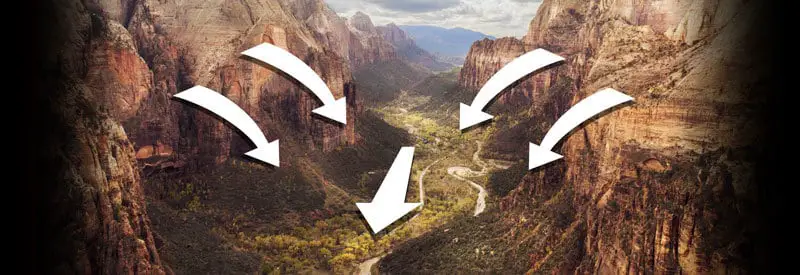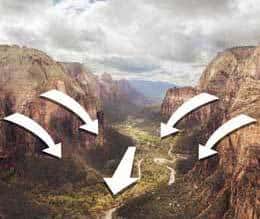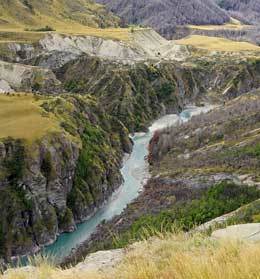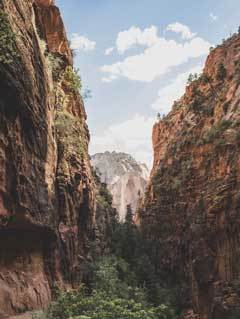Canyon Wind: What It Is And How It Forms

Wind is primarily the result of air pressure changes over distance and the pressure gradient. But topographical changes on the planet's surface can also create certain types of wind, like the canyon wind.
A canyon wind is an evening wind that occurs when canyon walls cool down and lower the air temperature above it, which flows to the base and down the valley due to the Earth's gravity. A strong low-level wind also forms when air is forced to accelerate in the narrow space between the canyon walls.
Variations on the planet's surface like steep elevations (mountains), valleys, plateaus, and canyons can play a significant part in the formation of weather. One weather element that is especially prone to variations on the surface is wind.
This article will focus on the role canyons (or canyon-like features) play in the formation of a type of wind called a canyon wind.
A canyon creates a unique environment where not one but two different types of canyon winds can form. This post will examine what they are and how they are formed.
What Is A Canyon Wind?
As the introduction already eluded to, a canyon's physical attributes allow for the formation of two distinct winds, both of which can fall under the term, canyon wind.
It is, therefore, crucial to have a clear and concise definition of these phenomena before exploring their creation and characteristics in more detail:
Canyon Wind Definition

A canyon wind is an evening wind that occurs when cold canyon walls cool down the surface air above, which flows to the base and down the valley due to the Earth's gravity. It is also a strong low-level wind that forms when air is forced to accelerate in the narrow space between the canyon walls.
From the definition alone, it is already evident that the two types of wind that are the result of an interaction with a canyon are distinct and very different from each other.
The wind that flows down the canyon walls in the evenings is also known as a mountain breeze, which may be more familiar to many readers.
The low-level wind that is the result of air being forced to flow through a confined space between canyon walls is also known as a gap wind.
The best way to gain a clear understanding of both winds is to examine the development and characteristic of each one individually.
Development Of A Canyon Wind (Mountain Breeze)
During the day, the sun heats the floor and slopes (walls) of a canyon. In turn, the heated surface warms up the air directly above it, causing it to expand and rise into the atmosphere. (This phenomenon is often referred to as a valley breeze.)

In the evening, the surface of the canyon walls cools down more rapidly than the surrounding atmosphere. The colder surface cools the air above it, causing it to contract and become denser as its temperature continues to drop.
The dense cold air is heavier than the surrounding atmosphere and starts to flow down the slopes to the canyon floor. The resulting airflow is called a canyon wind (often better known as a mountain breeze.)
Canyon winds can be quite strong due to the steep gradient of canyon walls. Where the canyon winds from the two opposing walls converge at the bottom, they can combine and follow the downward slope of the canyon floor as a single strong air current.
Development Of A Canyon Wind (Gap Wind)
As discussed earlier, a canyon wind in the form of a mountain breeze is not the only form of canyon wind that occurs.
When a low-level wind encounters a geological obstacle like a mountain, it needs to find a way past it. Since this type of wind is usually only a few hundred meters high, it is not always possible to maintain momentum and mass by flowing over the mountain.
When it encounters a gap in the mountain, like a canyon, the wind is forced to funnel through the relatively narrow channel created by the canyon. To maintain mass and momentum, air needs to accelerate, producing strong winds in the process.

The channeled wind that forms as a result of the funneling of air through a narrow space is called a canyon wind (sometimes better known as a gap.)
These types of canyon winds can reach high velocities of up to 93 km/h (58 mph). The speeds were thought to be at their strongest in the narrowest part of the canyon (called the Venturi Effect).
Recent studies concluded that this not the case since canyons are open at the top, allowing air pressure to force wind to rise over the mountain. They determined that the greatest wind speeds occur at the exit of a gap in the mountain (the canyon mouth.)
This type of canyon wind is not just limited to natural geological phenomena but also man-made structures.
Urban Canyon Effect
In densely populated urban areas, specifically city centers with tall buildings flanking city streets, a phenomenon identical to a canyon wind (gap wind) occurs quite frequently.
When low-level winds encounter a city center with its "wall of buildings," the narrow opening provided by streets acts as a canyon. Similar to canyons, the wind accelerates as it is channeled through this small gap, creating what is called an urban street canyon.
This urban canyon effect occurs when the wind hits the densely grouped buildings at a parallel angle, where the streets that are running in the same direction as the wind act as an escape route through which the wind can be funneled.
The urban canyon effect forms part of a broader meteorological phenomenon that occurs in large metropolitan areas called an Urban Heat Island.
Conclusion
What is clear from this article is that geological structures on the Earth's surface can play a huge role in the formation and modification of air movement. In the case of canyon winds, these structures can even result in more than one type of wind.
Canyon winds are unique since their structure allows them to create two distinctly different types of winds with their own characteristics. Also known as mountain breezes & gap winds, these forms of canyon winds can occur in similar environments under different names.
This article focused on the two types of canyon winds, how they develop, and also highlighted how urban environments could recreate the effect of certain canyon winds.
Never miss out again when another interesting and helpful article is released and stay updated, while also receiving helpful tips & information by simply clicking on this link .
Until next time, keep your eye on the weather!

